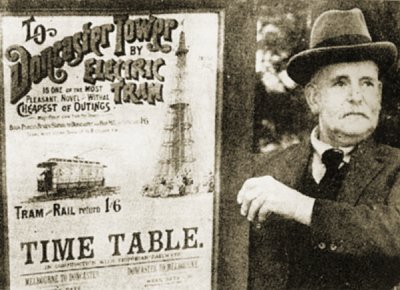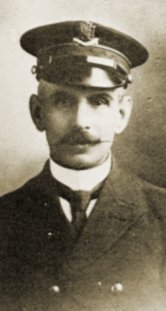Melbourne Tram Museum
- Follow Melbourne Tram Museum on Twitter
- Follow Melbourne Tram Museum on Facebook
- Follow Melbourne Tram Museum on Instagram
- Follow Melbourne Tram Museum on Pinterest
- Follow Melbourne Tram Museum on Tumblr
- Subscribe to Melbourne Tram Museum's RSS feed
- Email Melbourne Tram Museum
The Hiltons: bush tramway pioneers
In March 1893, a young and enterprising engineer named Henry Hilton became engineer for the struggling Box Hill to Doncaster Tramway Company, the first electric tramway in the Southern Hemisphere, which opened in 1889. Over the next year, despite the desperate economic conditions produced through the 1891 land boom collapse, he managed to keep the tramway running through continual improvements in electrical efficiency and other cost reductions.
However, despite these efforts the company could no longer continue operations, but the tramway kept running with the operation leased to Henry Hilton from 14 April 1894 for the princely sum of one shilling a week. He was assisted by his cousin William Hilton on what they called their ‘bob-a-week’ tramway service. The lessee was responsible for all operational costs except wear and tear, and had to keep the line in good order and maintain the winter timetable with additional services as required.
 Henry
Hilton, 50 years after the closure of the Box Hill tramway.
Henry
Hilton, 50 years after the closure of the Box Hill tramway. - Photograph courtesy Daryl Bunting.
One of the practices that the Hiltons used to save money was to shut down the generating plant and allow the tram to coast downhill from Doncaster to Koonung Creek along Tram Road, where the driver would signal the engine driver in the depot to start the plant up again for the run up to Box Hill. On one evening occasion the tramcar was loaded with 45 passengers travelling down this hill and the only method of stopping, the hand brake, failed to have any effect on the rocketing vehicle. The passengers did not notice the speed as there was no lighting besides a dim oil headlight, so they continued to sing ‘Hold the fort for I am coming’ as the tramcar sped down the grade and around the sharp curve on the bridge over Koonung Creek, coming to a halt three hundred yards up the next hill, leaving driver Henry Hilton relieved that nothing other than a scare had happened. The remainder of the trip to Box Hill was completed without incident.
It should be noted that no injury or accident ever occurred on the Box Hill to Doncaster line, although this was perhaps due more to luck than design.
Nonetheless the operation of an electric tramway through a sparsely inhabited rural area was never going to pay, and the valiant defence put up by the Hiltons finally ended in January 1896.
After closure of the tramway, William Hilton moved to Western Australia. However, his time on the Box Hill to Doncaster electric tramway would set his career direction for the rest of his life, so when the North Melbourne Electric Tramways & Lighting Company opened in 1906, he moved back to Melbourne and became a motorman. He subsequently transferred to the Prahran & Malvern Tramways Trust, becoming chief inspector by 1913.
 William
Hilton, Chief Inspector PMTT, c1913.
William
Hilton, Chief Inspector PMTT, c1913. - Photograph courtesy Carmel Moss.
After the formation of the Melbourne & Metropolitan Tramways Board in 1920, William Hilton rose to be district traffic superintendent of the eastern tramway system. He retired from that position in 1930 after a long and distinguished career in tramways.
Henry Hilton moved on to a role as an engineer at the Chiltern Valley gold mine in northern Victoria, introducing electric traction to the underground workings. He returned to Melbourne in 1911, becoming resident engineer at the West Doncaster Cool Store, where he installed Melbourne’s first electric street light.
Bibliography
Green, R (1989) The First Electric Road, J. Mason Press